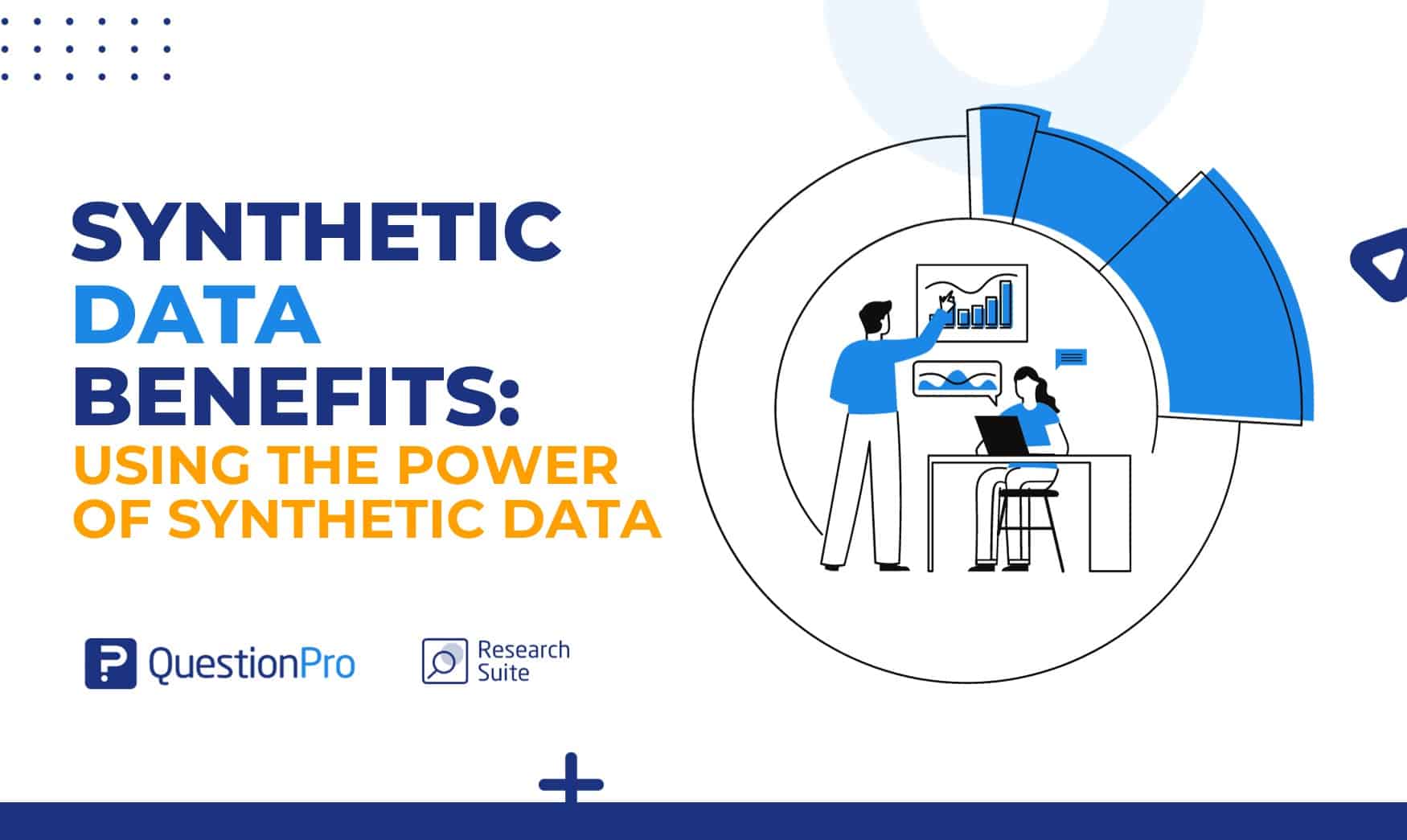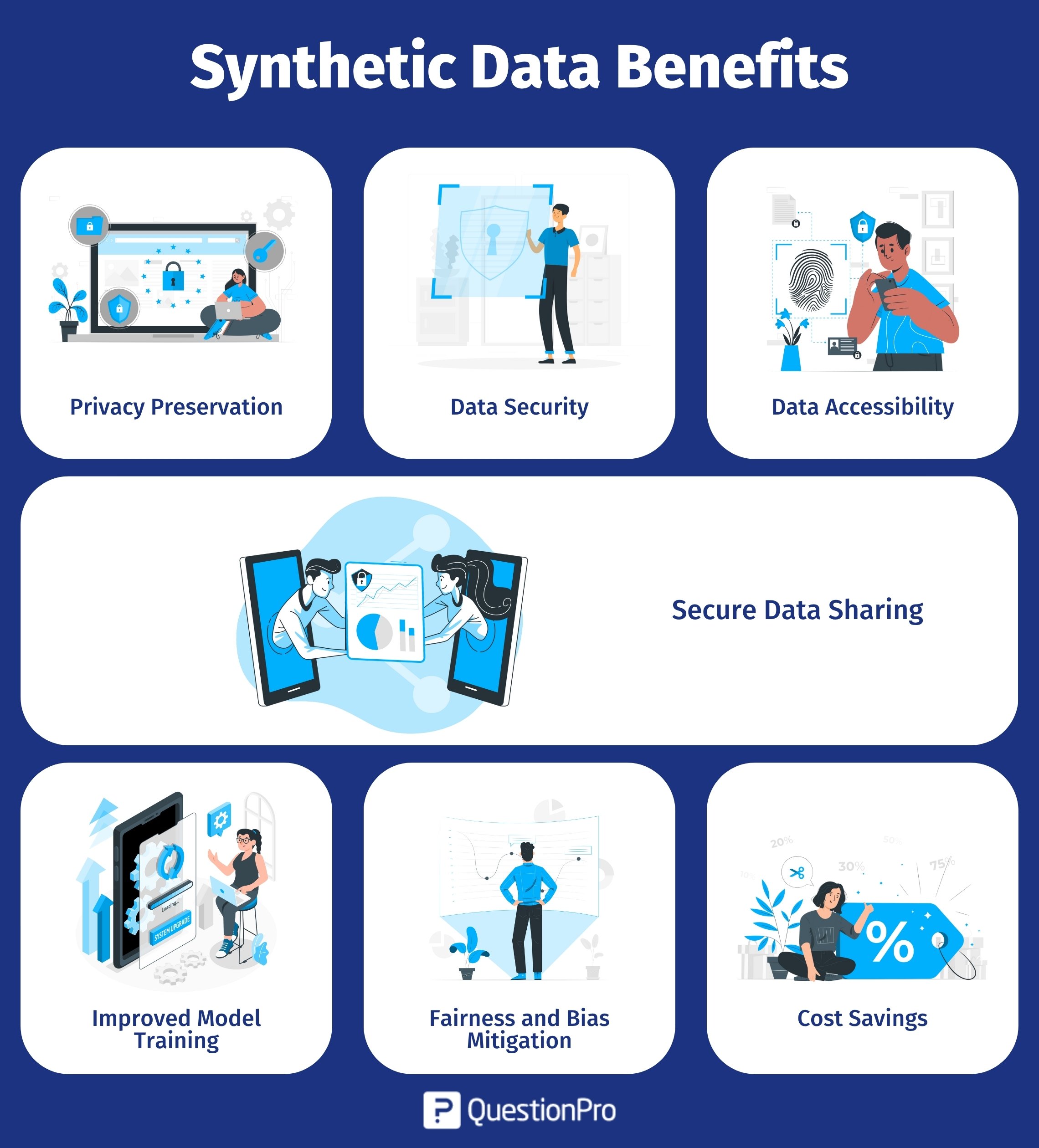
Have you ever faced challenges in running a survey because you didn’t have enough data, or the data you had was too sensitive to use? Maybe your target audience was hard to reach, or privacy regulations limited how you could share responses. You can take advantage of using synthetic data in these situations. Whether you’re building smarter models or trying to protect user privacy, synthetic data benefits with a fresh way to move forward without the usual limits.
In this post, we’ll explore the benefits of synthetic data that enhances survey research and why more organizations are using it to overcome data limitations while protecting respondent privacy.
What is Synthetic Data?
Synthetic data is artificially generated data that resembles real-world data but doesn’t contain any actual personal or identifiable information. It’s created using algorithms and patterns based on existing datasets, allowing it to simulate realistic responses without exposing real user details.
Synthetic data is used to improve the way surveys are designed, tested, and analyzed. It helps researchers try out different question formats, predict outcomes, and train analysis models without needing real responses right away. This makes it easier to protect respondent privacy, test survey effectiveness, and make data-driven decisions more quickly.
Synthetic Data Generation
Understanding the process of creating synthetic data is critical for understanding its potential and uses in a variety of disciplines. Synthetic data generation is a precise and planned process. It involves using various techniques and algorithms to generate data points that closely resemble real-world datasets’ statistical features, structures, and patterns.
While the data is generated, the idea is to make it indistinguishable from real-world data so that it can be used for AI and AI analytics projects, research, and ML model development.
- Statistical Distribution: This method creates fake responses that follow the same statistical trends as your real survey data. For example, if 60% of real respondents answered “Yes” to a question, the synthetic data would reflect a similar pattern.
- Generative Models: Advanced techniques like GANs (Generative Adversarial Networks) or VAEs (Variational Autoencoders) use machine learning to generate data that closely mirrors actual survey responses. These tools are great for creating large volumes of realistic survey data.
- Agent-Based Modeling: In this approach, simulated “agents” (representing survey respondents) interact in a virtual environment based on specific rules. Their decisions and behaviors generate patterns that can be turned into synthetic responses.
While synthetic data is a powerful tool, it’s not perfect. It may not always capture every nuance of real human responses. That’s why many researchers use it alongside real survey data—to balance privacy, accuracy, and usefulness.
Synthetic Data Benefits
Using synthetic data in survey research brings a wide range of benefits—especially when you’re working with sensitive topics, hard-to-reach audiences, or limited resources. It helps you collect insights, test ideas, and build smarter models while keeping privacy and compliance at the forefront. Here’s how synthetic data can support and strengthen your survey efforts:

Privacy Preservation
Privacy is a cornerstone of ethical survey research. When collecting sensitive or personal information from respondents, ensuring confidentiality is not just important; it’s essential. This is where synthetic data plays a key role in maintaining privacy without sacrificing data utility. How Synthetic Data Supports Privacy:
No Real Identifiable Information
Synthetic data mimics the patterns and behaviors of real survey responses, but it doesn’t contain any actual personal identifiers. This helps eliminate the risk of exposing participant identities.
Improved Anonymity in Sensitive Surveys
For surveys involving health, finance, or personal behavior, synthetic data can be used to generate datasets that reflect overall trends—while keeping individual responses completely anonymous.
Safe Collaboration and Data Sharing
Researchers, analysts, and collaborators can work with synthetic versions of the survey data, reducing the risk of data misuse or leaks during analysis or presentation.
Support for Data Compliance
Using synthetic data in survey research helps organizations meet privacy regulations such as GDPR, CCPA, or HIPAA, especially when real data cannot be shared or stored.
Data Security
In survey research, protecting respondents’ data is non-negotiable. Synthetic data provides a secure alternative to real responses, helping researchers maintain confidentiality without compromising analytical value.
Unlike actual survey data, synthetic datasets do not contain identifiable personal information. This means even if the data is accessed by unauthorized users, no real identities or sensitive responses are exposed. It reduces the risk of data breaches and helps organizations remain compliant with data protection regulations like GDPR or HIPAA.
Synthetic data also allows for secure collaboration. Research teams, analysts, or third parties can work with survey-like data structures and patterns without accessing actual participant details. This is particularly valuable when testing models, conducting training, or sharing survey data externally.
By replacing sensitive datasets with synthetic alternatives, survey researchers can ensure both data utility and privacy—maintaining trust while mitigating security risks.
Data Accessibility
Access to quality data is crucial for effective survey research, but privacy rules and data sensitivity often limit who can use real survey responses. Synthetic data improves accessibility by providing safe, realistic datasets that can be shared widely without risking participant privacy.
This makes it easier for different teams, like researchers, analysts, or developers, to collaborate, test survey designs, and run analyses without restrictions. By reducing barriers, synthetic data accelerates decision-making and innovation in survey projects.
Secure Data Sharing
Sharing survey data across teams or with external stakeholders is often necessary—but it comes with risks. Synthetic data offers a safer way to collaborate without exposing actual respondent information.
By mimicking the patterns and structure of real survey responses, synthetic datasets allow researchers to share insights freely while keeping personal data protected. This makes it ideal for scenarios like:
- Sharing data with third-party vendors or consultants
- Conducting cross-functional analysis within large organizations
- Training machine learning models without breaching confidentiality
Since the data isn’t linked to any real individuals, there’s no risk of re-identification or misuse. This improves trust and speeds up collaboration, especially when legal or compliance reviews are involved.
Synthetic data supports safe, effective data sharing in survey workflows, combining insight generation with strong privacy protection.
Improved Model Training
Training predictive models or analytics tools often requires large, balanced datasets—but real survey data can sometimes be limited or uneven. Synthetic data helps fill those gaps by creating realistic, artificial responses that boost your dataset size and diversity.
This means you can:
- Augment Small Survey Samples: Generate more data points when your actual respondent pool is too small.
- Balance Underrepresented Groups: Create synthetic responses to even out imbalanced demographics or answer distributions, improving model fairness.
- Improve Accuracy: Models trained on richer, more varied data tend to perform better and make more reliable predictions.
By incorporating synthetic survey data into your training process, you reduce bias, increase robustness, and build smarter, fairer analytics models, all without compromising respondent privacy.
Fairness and Bias Mitigation
Bias in survey data can lead to unfair or misleading conclusions, especially when certain groups are underrepresented or questions unintentionally favor some responses. Synthetic data offers a practical way to identify and address these issues before making decisions.
By generating balanced synthetic survey responses, researchers can:
- Detect Hidden Biases: Compare synthetic data with real responses to spot where bias exists.
- Create More Inclusive Samples: Add synthetic responses to underrepresented groups to balance the dataset.
- Test Survey Designs: Simulate how different questions or formats affect fairness.
Using synthetic data in this way promotes ethical research practices and helps ensure survey results accurately reflect the diverse populations you want to understand.
Cost Savings
Collecting survey responses can be costly and time-consuming, especially for large or specialized groups. Synthetic data helps reduce these costs by creating realistic, artificial responses that supplement or replace real data collection. This means fewer surveys to run and less money spent.
Since synthetic data doesn’t include personal details, it also lowers storage and security expenses. Plus, it speeds up your projects by letting you test and analyze without waiting for new responses. Overall, synthetic data helps survey teams save time and money while protecting privacy.
Challenges of Using Synthetic Data
While synthetic data offers many benefits, it also comes with some challenges that you should be aware of. These issues can affect how useful, accurate, and trustworthy the data is, especially when it’s used in real-world applications. Let’s take a look at some of the main challenges:
While synthetic data can be incredibly helpful, especially for surveys, it does come with a few challenges. These issues can affect how reliable, useful, or fair the data is. Let’s break down some of the key concerns.
- It’s hard to make synthetic data feel as real and natural as actual survey responses.
- Synthetic data often struggles with generalization and may not perform well in real-world survey scenarios.
- It may carry hidden biases if the original data used to generate it had unfair patterns or lacked diversity.
- Ensuring synthetic data is accurate requires careful validation, which isn’t always straightforward.
- The generation method affects the quality of your synthetic survey data.
- Stakeholders may doubt synthetic data without understanding its creation or security.
Best Practices of Synthetic Data for Maximizing Benefits
To make the most out of synthetic data in survey research, it’s important to follow certain best practices. These help ensure the data remains useful, ethical, and aligned with your research goals.
Define your survey objective – Know exactly why and how you plan to use synthetic data.
- Ensure data privacy: Follow ethical standards and data protection regulations.
- Start with clean seed data: Use high-quality real survey data as your base.
- Reduce bias: Identify and correct any bias in both original and synthetic data.
- Validate results: Regularly check if synthetic data aligns with real survey responses.
Conclusion
Synthetic data benefits are vast. It protects respondent privacy, supports innovation, improves model performance, and enables safe data sharing. By mimicking real survey responses, synthetic data allows researchers to explore insights without compromising confidentiality or needing large real datasets.
Using synthetic data in survey research opens up new opportunities to analyze and act on data securely and efficiently. As technology advances, it will become an essential tool in data-driven decision-making.
QuestionPro supports this by collecting authentic survey data, ensuring anonymity, enriching datasets, and enabling secure sharing. It empowers organizations to use synthetic data responsibly, speeding up innovation while maintaining compliance with privacy standards.
Frequently Asked Questions (FAQs)
Answer: Yes, when properly generated and validated, synthetic data can closely reflect real patterns and distributions. However, it’s important to compare synthetic results with real data and ensure validation for better reliability.
Answer: Not entirely. Synthetic data works best when used alongside real survey data for testing, training, or privacy-safe sharing. It can supplement limited datasets but may not capture every nuance of genuine human response.
Answer: Because it doesn’t include real personal identifiers, synthetic data ensures that no individual respondent can be re-identified. This makes it ideal for research involving sensitive topics or strict compliance requirements.
Answer: Absolutely. It can augment small datasets, balance underrepresented groups, and increase diversity, leading to more accurate and fair survey-based models.
Answer: If the source data used to generate synthetic data is biased, those biases can be replicated or even amplified. It’s crucial to audit and validate the output for fairness and accuracy.







